
2025 Dolomites-Veneto: Vines and Classic Climbs
SEPTEMBER 5-21, 2025
The Dolomiti (Dolomites) take their name from the scientist who first recognized the rock formations as different and distinct from all
other formations in Western Europe. Indeed, the Dolomiti are primarily formations resulting from the uplift of ancient coral beds of the
nearby Mediterranean Sea. The near vertical walls create stunning vistas and lens filling landscapes that are unparalleled. The high
pastures provide a beautiful green tapestry of contrasting color where herds graze and flocks migrate to higher ground during the hot
summer months. The herder and hiker huts provide refuge from sudden storms and a welcome respite for hungry travelers traversing
historic trade routes linking remote valleys and villages.
The fertile Veneto region is today the epicenter of Italian cycling manufacturers of clothing, components, frames, shoes and tires. The
prosecco grape grows in abundance on the hillsides of the Veneto and provides ample fruit for the sparkling prosecco wine that is
prominently featured on dinner tables of Italian families. Famous cities of the Veneto include Verona and Venezia (Venice) are known
throughout the world for music, verse and handcrafts. The ancient silk route passed through the Veneto and over the Alps to northern
Europe leaving us with amazing roads to ride into the heart of the mountains. Monte Grappa dominates the skyline to the north of
Castelfranco and is a favorite route for cyclists of the Veneto.
Leaving the Veneto plain we ride upstream along the beautiful Brenta river on roads designated for cycling enjoyment and where
kayakers play amid riffles and rapids. Our route passes between two massifs that separate the Veneto from the mighty Dolomite
mountains.
We continue our warm-up approach to the Dolomiti as we follow the “Wine Route” of the Alto Adige between Trento and Bolzano.
Along the way we traverse apple orchards and vineyards where we glimpse the stunning beauty of the Dolomiti. We will sleep in the
shadows of the Dolomiti and Brenta ranges and enjoy local wines produced from nearby vines of Mezzocorona, Val di Non, Caldaro
and Bolzano. Marketday is Saturday in Bolzano and we will have the day to explore this historical town at the confluence of Adige and
Isarco rivers; a natural hub of trading and commerce.
Rising high above the Adige River we finally arrive on the western shoulder of the Dolomiti beneath the Scilliar cliffs. We are entering
the heart of the Dolomiti as we climb passes made famous by il Giro della Italia. The famous Sella Ronde becomes our domain for the
next few nights before cycling further into the dramatic peaks and valleys of the Dolomiti. The serpentine routes of Passo Pordoi,
Passo Pellegrino, Passo Giau and the mighty Marmelade beckon us to press ever upward to view stunning scenery. Cortina
d’Ampezzo is the Aspen of Italian skiing circles, so we are treated to great meals and gracious hospitality from our Italian hosts.
Completing our tour, we pedal along the picturesque strada della vino as we leave the Dolomiti behind us. We will arrive back at our
hotel in Castelfranco in time to pack our bikes before a fond farewell dinner and a final gelato in the piazza.
SEPTEMBER 5-21, 2025
Arrival Day 1
September 5, 2025
Castelfranco in Veneto
31-64 miles with 950-6500 feet climbing
We meet you at Venezia (Venice) Marco Polo airport for transfer to Castelfranco or to collect your luggage. Water taxis are available
directly from the airport to transport you into the heart of Venice for an afternoon exploring the canals and passageways of this romantic
Italian town. Trains leave from the banks of central Venice to transport you to the center of Castelfranco on a regular basis.
Our hotel in Castelfranco is ideally located in the heart of the old town, where you will find an abundance of cafes, gelateria and shops.
We will assemble bikes in the basement of our hotel and organize a shake-down ride prior to our evening meal. The ride is thru the
farmland and vineyards of the fertile Veneto region with a delightful stop in Asolo, one of the most enchanting regions in Italy, for our
first taste of gelato.
An Italian dinner tonight within the walls of the old town is planned as a welcome to the Veneto and Dolomiti. And we will enjoy the fine
Italian tradition of a post-dinner walk with gelato and perhaps cafe.
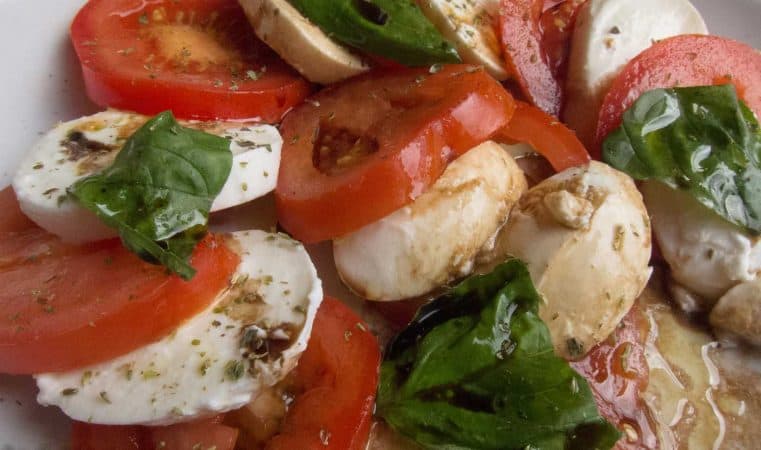
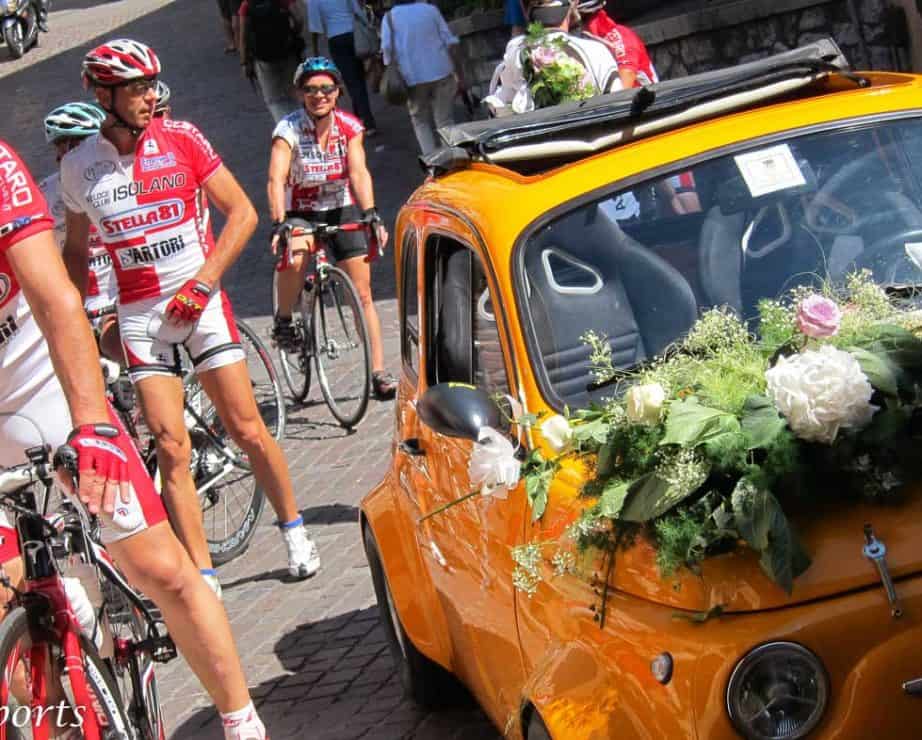
Our hotel in Castelfranco is ideally located in the heart of the old town, where you will find an abundance of cafes, gelateria and shops. We will assemble bikes in the basement of our hotel and organize a shake-down ride prior to our evening meal.The ride is thru the farmland and vineyards of the fertile Veneto region with a delightful stop in Asolo, one of the most enchanting regions in Italy, for our first taste of gelato. An Italian dinner tonight within the walls of the old town is planned as a welcome to the Veneto and Dolomiti. And we will enjoy the fine Italian tradition of a post-dinner walk with gelato and perhaps cafe.

Day 2
Warmup Rides
31-64 miles with 950-6500 feet climbing
Monte Grappa is an iconic climb of the Veneto, just 26km from Hotel alla Torre in the heart of Castelfranco-Veneto. Rides for today
include 2 Monte Grappa and 5 Asolo loops. Let your legs choose which you ride. Or maybe combine them for an amazing ride. We
are always available to provide subjective descriptions for each of the digital routes.

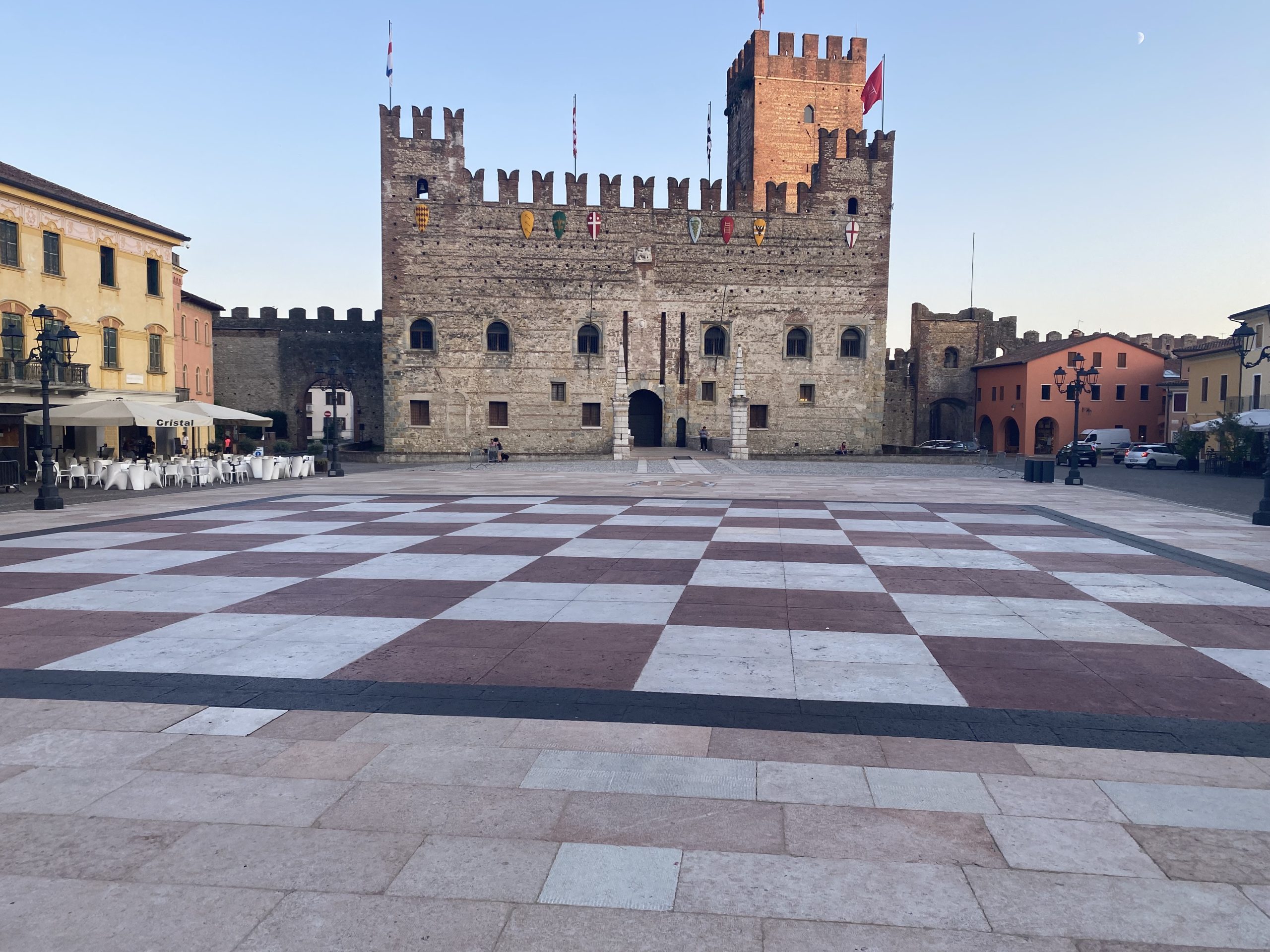
Day 3
Castelfranco to Marostica
4 routes
27-69 miles with 820-8370 feet climbing
Following in the footsteps of the inhabitants of Vicenza, we’ll head north toward base of Monte Grappa (foothills of the mighty
Dolomites). The fertile Veneto region has nurtured the creative soul of Italian culture from the early 800’s to modern times. Bassano
del Grappa, famous for its ceramics and distilled liquor, is a fascinating town, inviting exploration and a mid-day lunch at one of many
small restaurants. We ride thru Bassano del Grappa and across the recently restored footbridge across the Brenta river in the old
section of town. From here we ride along the base of the Asiago plateau to the medieval town of Marostica with it’s lifesize chess board
forming the central piazza in town.
Day 4
Levico-Terme
3 routes
46-69 miles with 2400-6600 feet climbing
The Asiago plateau separates the Brenta and Adige rivers from each other and forms the dominate cheese producing region by the
same name. Rather than climb into the sky, we ride along the banks of the Brenta river upstream to Valstagna on the way to Levico-
Terme; a favorite spa and summer recreation area. The grades are gentle and the scenery always changing; we have 3 great rides in
store for you today; two (2) climbers routes and a lovely Brenta River ride on farm roads and cyclepaths through old villages.

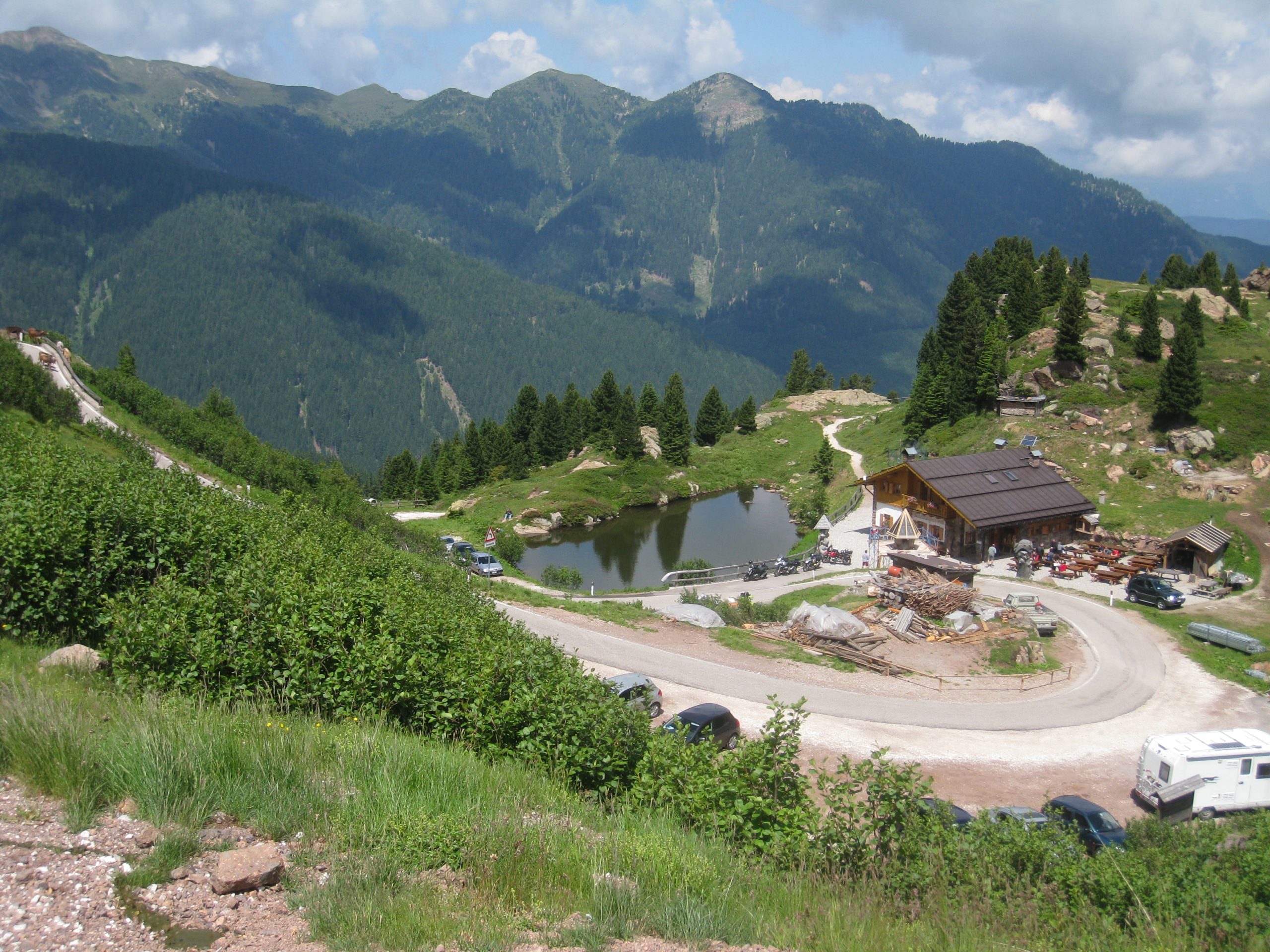

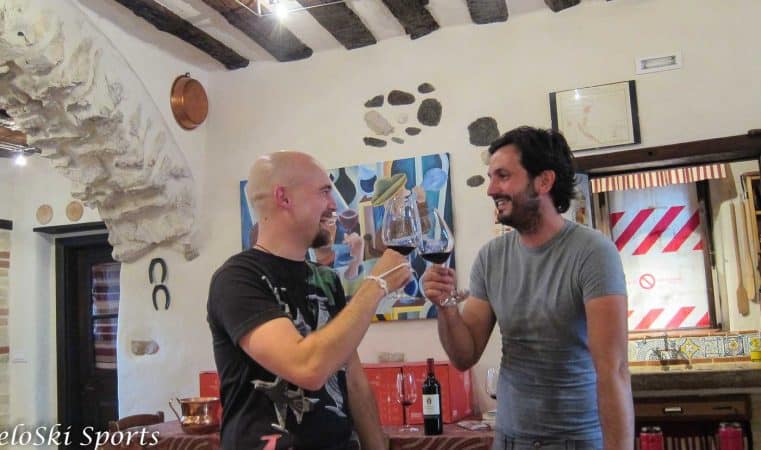
Day 5
Levico-Terme loop options
3 routes
17-68 miles with 3200-10800 feet climbing
Levico-Terme is a spa town with thermal baths and a shallow lake suitable for swimming. Our hotel also features a wellness center and lovely grounds for relaxing after riding. Nearby is Castel Pergine; a great destination for an easy spin to enjoy a late morning cappuccino and explore this historic castle dating back to the 13th century.
The Passo Mengen is the highlight of this option; we fell in love with this route option several years ago. As it happened, a couple of riders on our Dolomiti-Classic Climbs tour looked at the map and asked about the Passo Mengen. I said, “sure, let’s see what it looks like.” Well, 9 hours and 3600m of climbing later we arrived in Kaltern totally worn-out, but very happy to know another great climb in2025 Dolomites-Veneto: Vines and Classic Climbs — September 5-21, 2025
the Dolomiti; Passo Manghen remains one of their favorite all-time climbs. The loop route from Levico-Terme is not nearly as daunting; and we are treated to one of the most picturesque pastoral climbs in the Dolomiti region.

Day 6
Mezzocorona
4 routes
37-85 miles with 3900-12350 feet climbing
Today we leave the foothills of the Dolomites and ride into the Trentino and Alto-Adige wine growing regions. We ride along the shores of Lago di Levico to Pergine Valsugana for both routes to the base of Castel Pergine.
Trento option
The Trento route uses cyclepaths and mellow roads as we ride over a ridge to descend into Trento. Trento is a busy city with centuries of history as one of the “gate-keepers” of the most important trade-routes between Italy and Northern Europe (Germany, Austria, Czech, Belgium, France). It is a little busy leaving the northern edge of Trento, but then we join the beginning of one of the longest “cycle-paths” in Europe.
Altopiano di Pine – Cembra option
Climbing up to Altopiano di Pine takes us thru pine forests and meadows until we emerge amid meadows and streams on a high plateau leading us toward the southern edge of the Dolomites. We intersect and follow one of the roads toward the Trentino valley as we ultimately descend to Mezzocorona.
Arriving in Mezzocorona we immediately understand the importance of wine from the vines of the Alto-Adige; large and small wineries seem to be placed at every cross-road. Mezzocorona is an unassuming tow



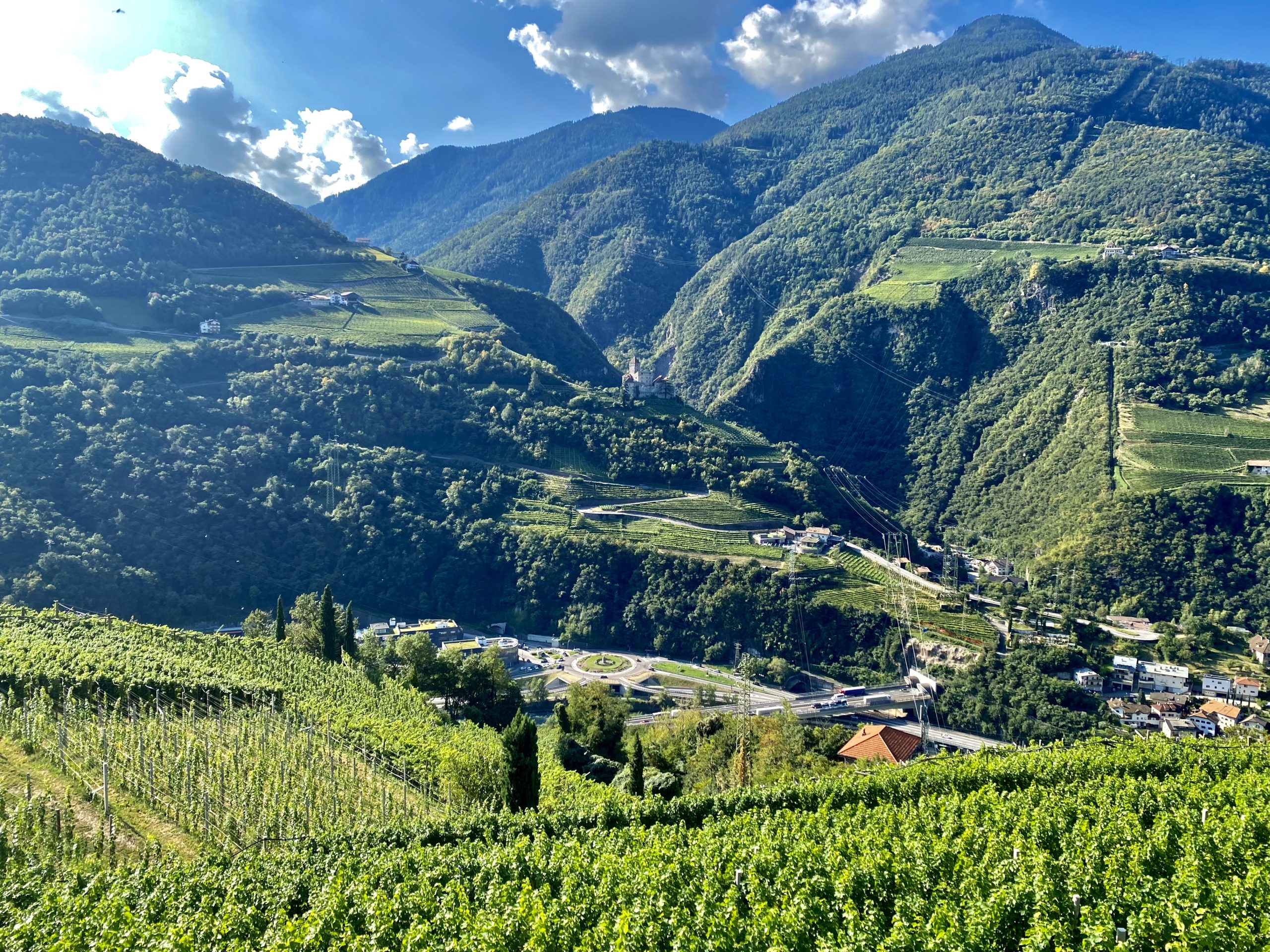
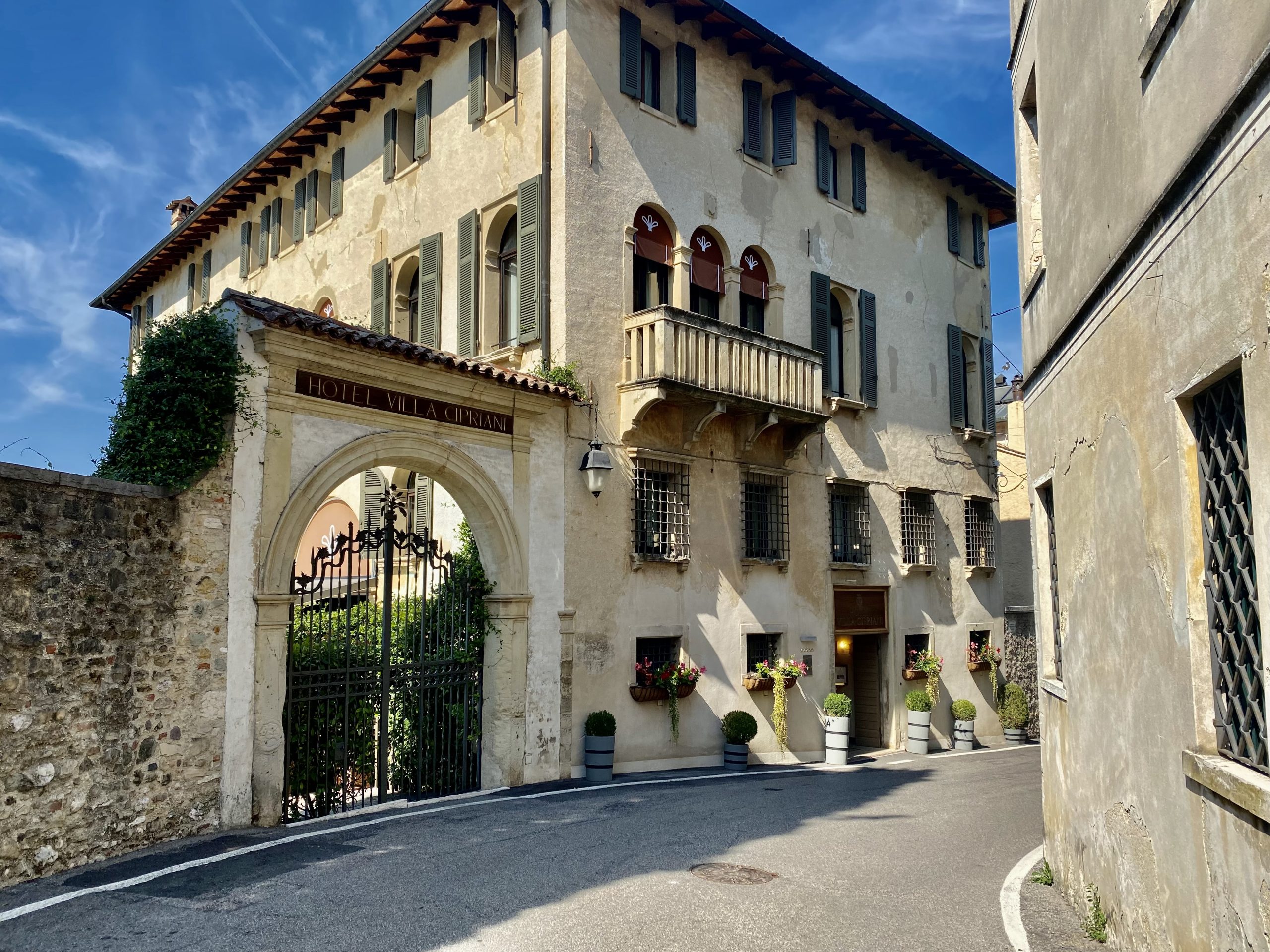
Day 7
Mezzocorona-Bolzano
3 routes
30-55 miles with 2000-5900 feet climbing
OK…vineyards, orchards, river paths, castles, wineries and mountains…does it get any better? The choice today is between vineyards or orchards; the val di Non or the Strada dello Vino.
Strada dello Vino or Weinstrasse route
We’ll ride quiet vineyard roads linked to the riverside bikepath to intersect the SüdTirol Weinstrasse along the way to Bolzano (Bozen). We are entering the historically Austrian region where the majority of the populace is of Austrian (Sud Tirol) descent. Politically the region was brought into Italy’s borders after WW-I, but the people retain their rich traditions and customs. The riding is pleasant and the visual treats are many along the route. Make sure your cameras are charged and you have plenty of memory available for capturing the moments of the day. Note: because of cultural duality road signs indicate town names in both Italian and German; both names are generally listed on our maps too.
Val di Non apple orchards route
Leaving Mezzorcorona on a quiet road, we wend our way up into the apple orchards of Val di Nons. Then we follow quiet roads to Passo Mendola where breathtaking views form the backdrop for lunch with a view. Descending to the distant Strada del Vino (Weinstrasse) is an Alpine descending delight. Finally after 14km we come to the Weinstrasse near Appiano (Eppan) where to avoid auto traffic we jump on a radweg (pista ciclabili) that takes us on vineyard roads to the outskirts of Bolzano. Using our RidewithGPS digital routes we are lead to our hotel for the next couple of nights.
The medieval city of Bolzano is truly the “gateway” to the Dolomiti with castles, spires and cathedrals pointing the way to the mountains. We have scheduled two days in town to fully appreciate the richness of the culture and history dating back over a thousand years. Our hotel is strategically located near the historical center of town.
Day 8
Bolzano loops or site seeing
3 routes
38-43 miles with 1320-6100 feet climbing
Bolzano is home to Otzi the IceMan discovered in a glacier by hikers in 1991. He was born during the Copper Age. The South Tyrol Museum of Archaeology has the whole historical story. Of course, we have a few cycling options:
• relaxing cyclepath upstream to Klausen for lunch and back
• energetic vineyard climbs from Bolzano and farmroads climb from Ponte del Gardena to Siusi, then a super fun swooping descent back to Bolzano
• Or some combination of these two routes
Or a day relaxing in the gardens by the hotel pool may be enjoyed after cycling or not cycling.
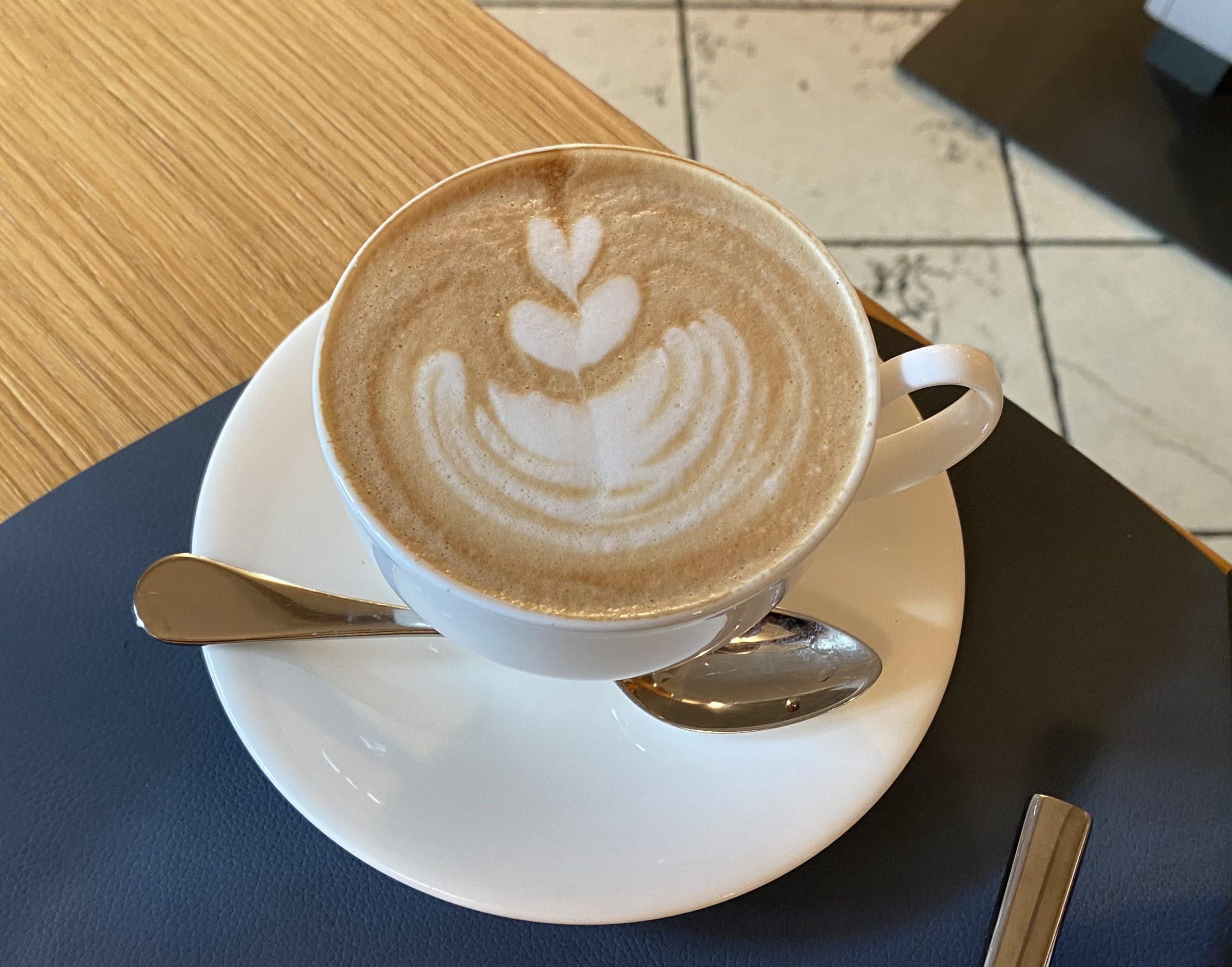


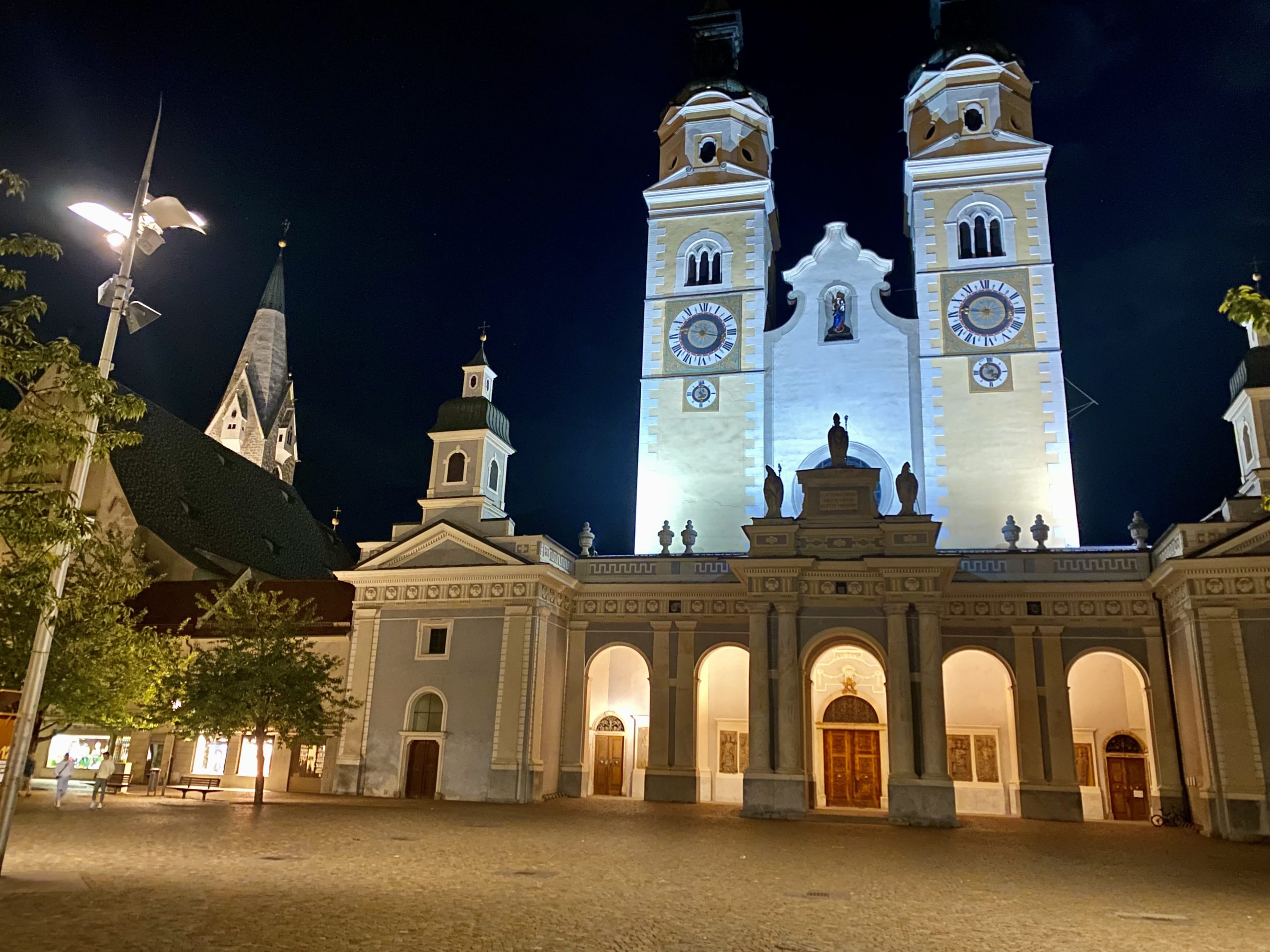
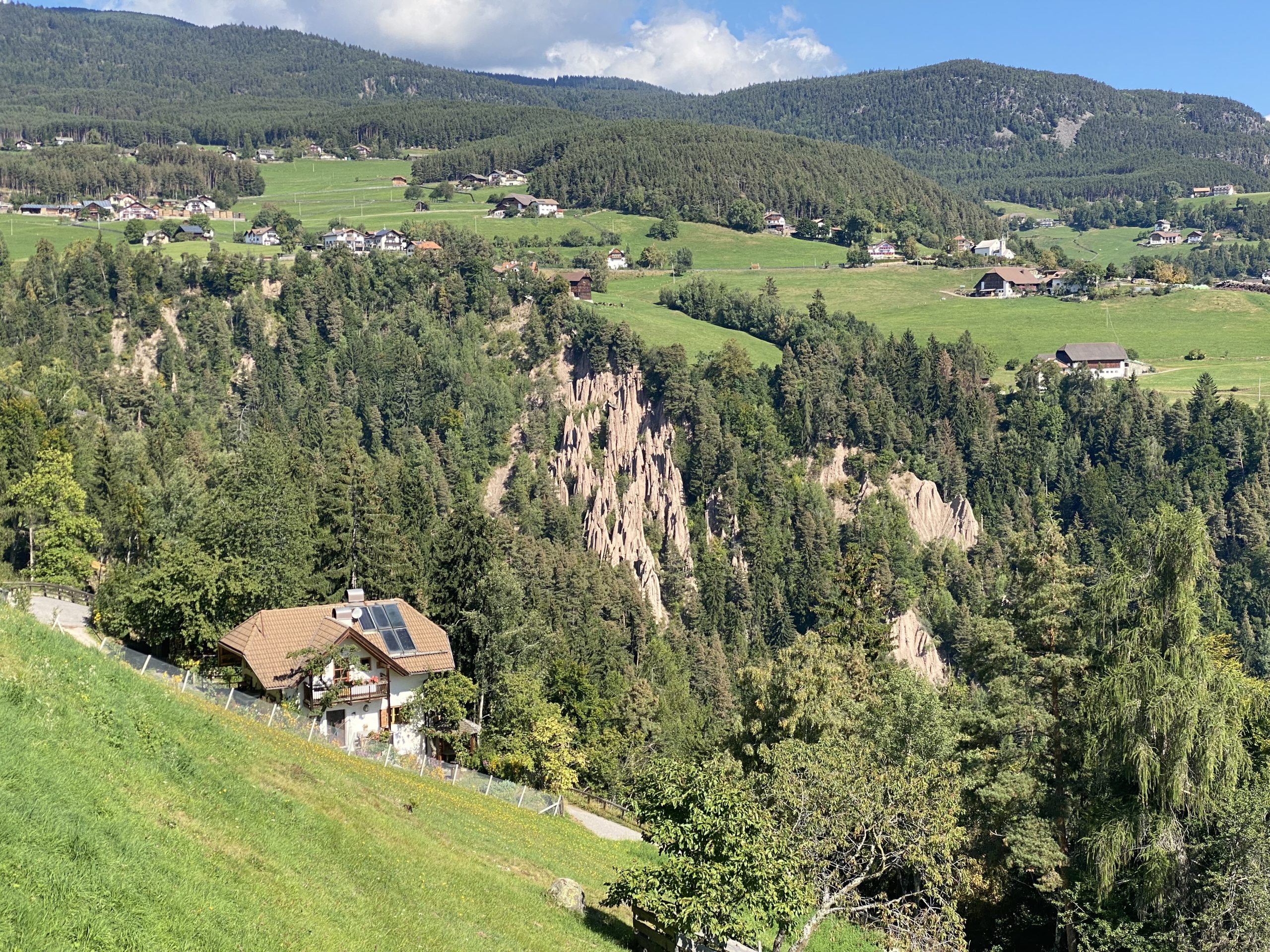
Day 9
Bolzano to Brixen
4 routes
28-54miles with 1650-9230 feet climbing
Bolzano is the gateway to the Dolomiti and our route today affords us amazing views into the wonderful and magical Dolomiti from our high pastoral farmroad traverse high above the Isarco (Eisach) river. The 900m (3000ft) climb from Bolzano up to Collabo (Klobenstein) begins by winding thru hillside vineyards as we leave the city below us in the distance. Or you may prefer to meander upstream along the Isarco river to join our friends in Klausen for the final segment of the ride to Brixen.
Collabo (Klobenstein) to Barbiano is only 17km, but sometimes it takes me over 2 hours to cover the distance. The reason: too many photo-ops to really get any serious riding done. The sunnier and clearer the skies, the longer it will take you to follow this amazing traverse. Enjoy!!
Eventually all things that go up must come down, so we stay on the high traverse as long as possible. Finally we will descend to Chiusa (Klausen) and join the bike-route into Brixen. Brixen celebrated it’s 1000 year birthday a few years ago, so you know that this is a special town to visit. The twin towers of the church are stunning and the main square facing the church is a great place to enjoy an afternoon beverage or gelato.
Day 10
Brixen to Corvara in Badia
47 miles with 6400 feet climbing
Wurzjoch lunch stop option
40 miles with 7750 feet climbing
The Five Passes (Afers, Wurzjoch, Valparola, Falzarego, Campolongo)
65 miles with 11,700 feet climbing
Cima di Plose, the dominant peak high above Brixen is the source of exceptional water and a “sleeper” ski arena. Our ride skirts the southern edges of Cima della Plose as we climb from the Isaco (Eisaktal) rive high on the flanks of val di Eores.and thru a pastoral high valley leading to Wurzjoch (Passo della Erbe). The roads become very quiet as we leave Brixen below us in the valley; it’s a little steep in the beginning. Passing thru Sankt Andra the grade lessens just enough for our legs to relax into a comfortable rhythm for the remainder of the 20km climb to Afers (Eores). A short downhill reprieve before the final 11km of climbing to the Wurzjoch (Passo Erbe) beneath the vertical walls of the Dolomiti mountains.
Wurzjoch (Passo Erbe) – the spinatknodeln (spinach dumplings) served on the terrace of Albergo Alpino are a must before dropping into the Alta-Badia region. Superlatives scarce capture the immense vistas and topographical relief visible on a clear day. Enjoy!!
From Passo Erbe we mostly descend to Alta-Badia, before a final moderate climb to Corvara.2025 Dolomites-Veneto: Vines and Classic Climbs — September 5-21, 2025 Museum Ladin ciastel de Tor (Ladin Museum – Tor Castle) – 46k m, 1245m – The fortress, whose history dates back to the 12th century, was once an ancient seat of the court of law. The castle itself thus provides an essential contribution to the history of the Dolomiti Ladins who are the descendants of the Romanized original inhabitants of the land and thus the most ancient of the three linquistic groups in South Tyrol. The museum presents archeological and historical information about the Ladin people and culture. You will note signposts listing the names of towns using the three different languages: Ladin, Italian and Austrian.

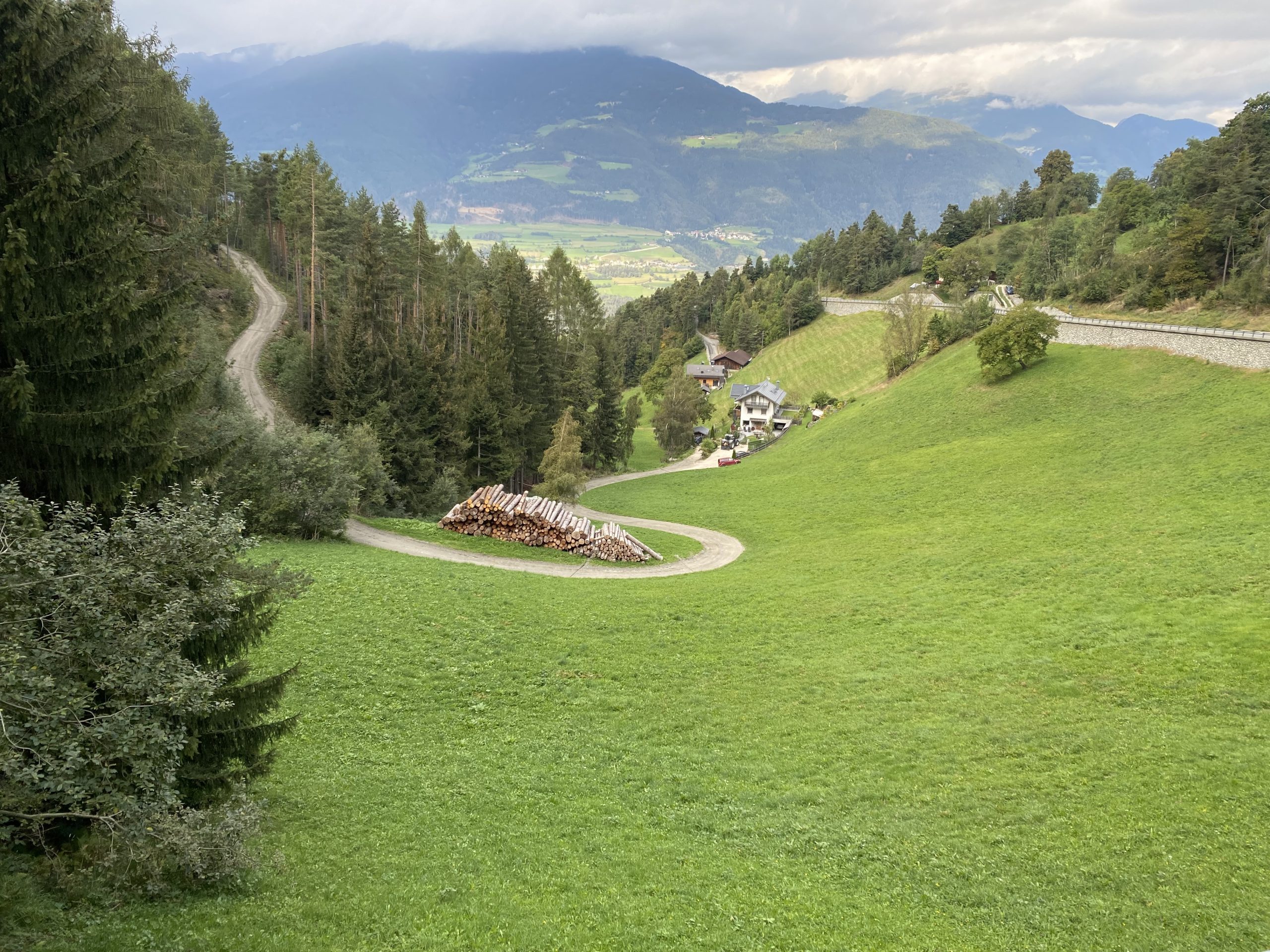
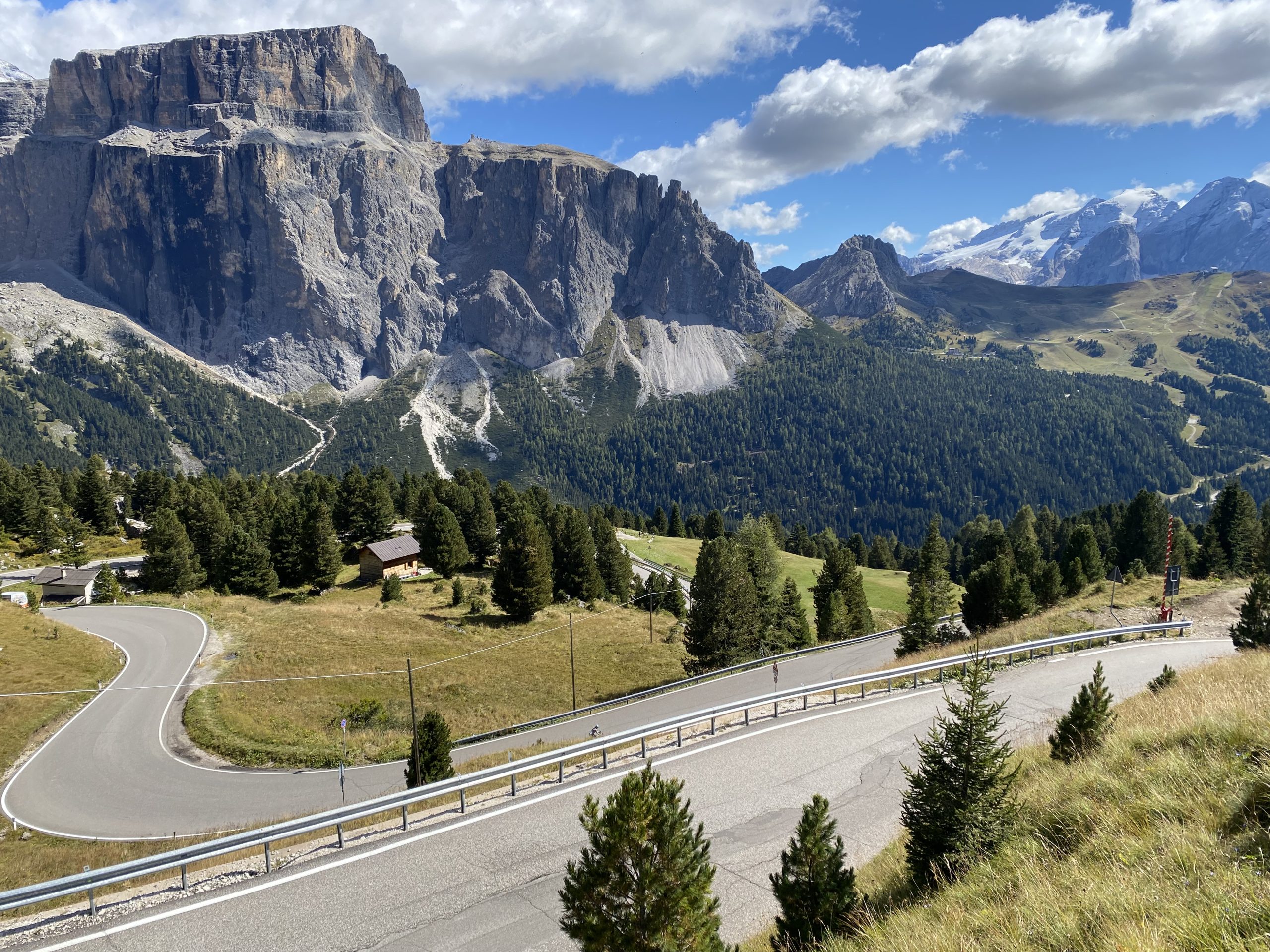

Day 11, 12 Corvara loops and The Mighty Sella Ronda Loop
5 routes
32—62 miles with 4400—10100 feet climbing
Corvara in Badia is the epicenter of the Alta-Badia ski region. Our hotel the Posta Zirm is family owned and operated by the same family that settled in Corvara some 200 years ago. Franz Kostner was the first one who built a chair lift in Italy to the Col Alto and founded a private transport company to bring tourists to the valley. Today, three generations of Kostner family members are actively involved with daily operations; personally greeting guests during dinner or checking guests in at the reception. Truly a wonderful “home” for three nights. Stay over days are some of my favorites, and Corvara is the top of my list for stayover variety of cycling, hiking and relaxing. We have 5 detailed digital routes to choose from for enjoying the beauty and grandeur of the “Heart of the Dolomites”. Not to be missed is the renowned “Sella Ronde”; 4 passes 32 miles with 6400 feet of climbing. There are cafes at the top of each pass too. There is a tram just outside the front door of our hotel that will whisk you up to the high meadows where you can enjoy a leisurely Alpine hike to wonderful restaurants with spectacular views of the adjacent Dolomite table top peaks.
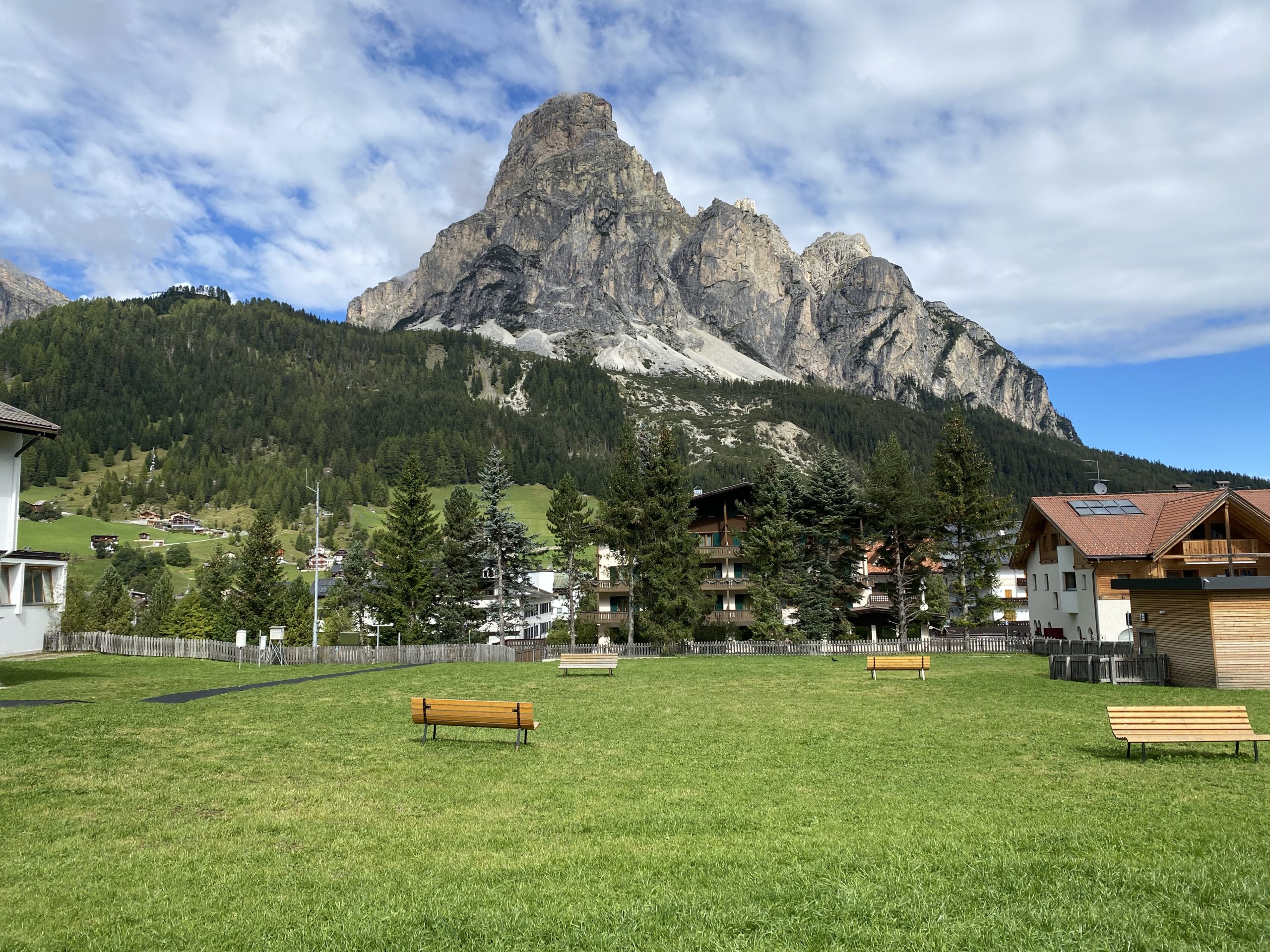
Day 13
Corvara to Cortina d’Ampezzo
9 route options
30—86miles with 3768—11040 feet climbing
The roads crisscrossing the Dolomiti are many, so the choice of where to ride is difficult. In Italy it is often said that all roads lead to Rome, but today our choices all lead to Cortina d’Ampezzo. The question is which views you want to see along the way. Whether you choose to ride in the shadow of the mighty Marmolada or cycle the valleys leading to the Passo Falzarego you will not experience visual or sensory disappointment; it’s all a good thing. Either way we all share the gentle climb over the Passo Campolongo and descend to Arraba before making our choice for today. Perhaps in the Dolomiti we should say, “all roads lead to beautiful times”.


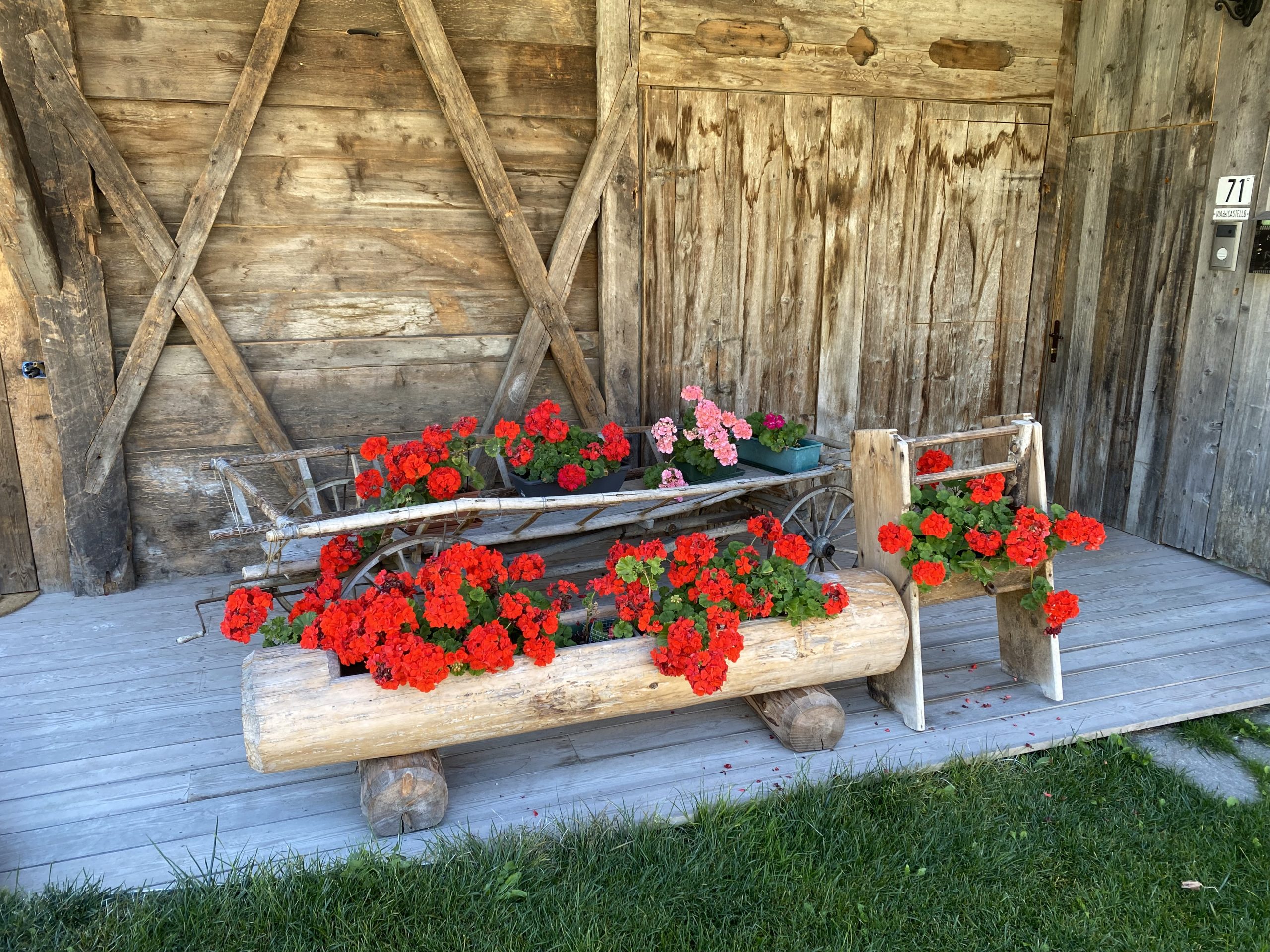
DAY 14 – CORTINA D’AMPEZZO : FELTRE
4 route options
26—70 miles with 2900—7200 feet climbing
Our stay over day affords ample opportunity for additional enjoyment whether cycling the Lago di Misurina loop or climbing to the mighty Tre Cime di Lavaredo. Again, wandering the pedestrian plaza “window shopping” or a short spin on an old railroad bed it’s all good. Or perhaps wander over to the Ice Arena or Bobsled run being prepared for the 2026 Winter Olympics.
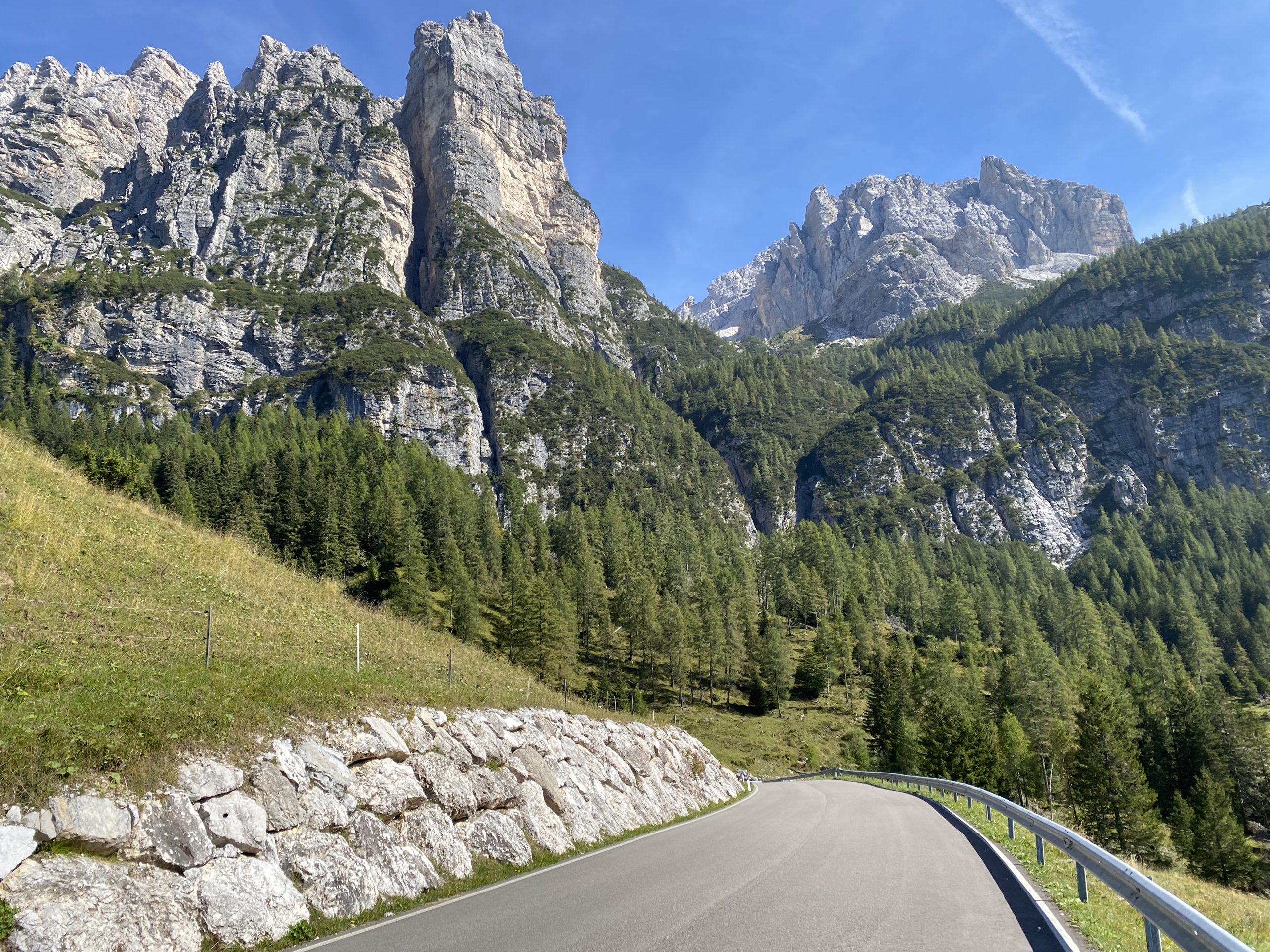


Day 15
Cortina to Feltre
4 routes
68—92 miles with 3400—13000 feet climbing
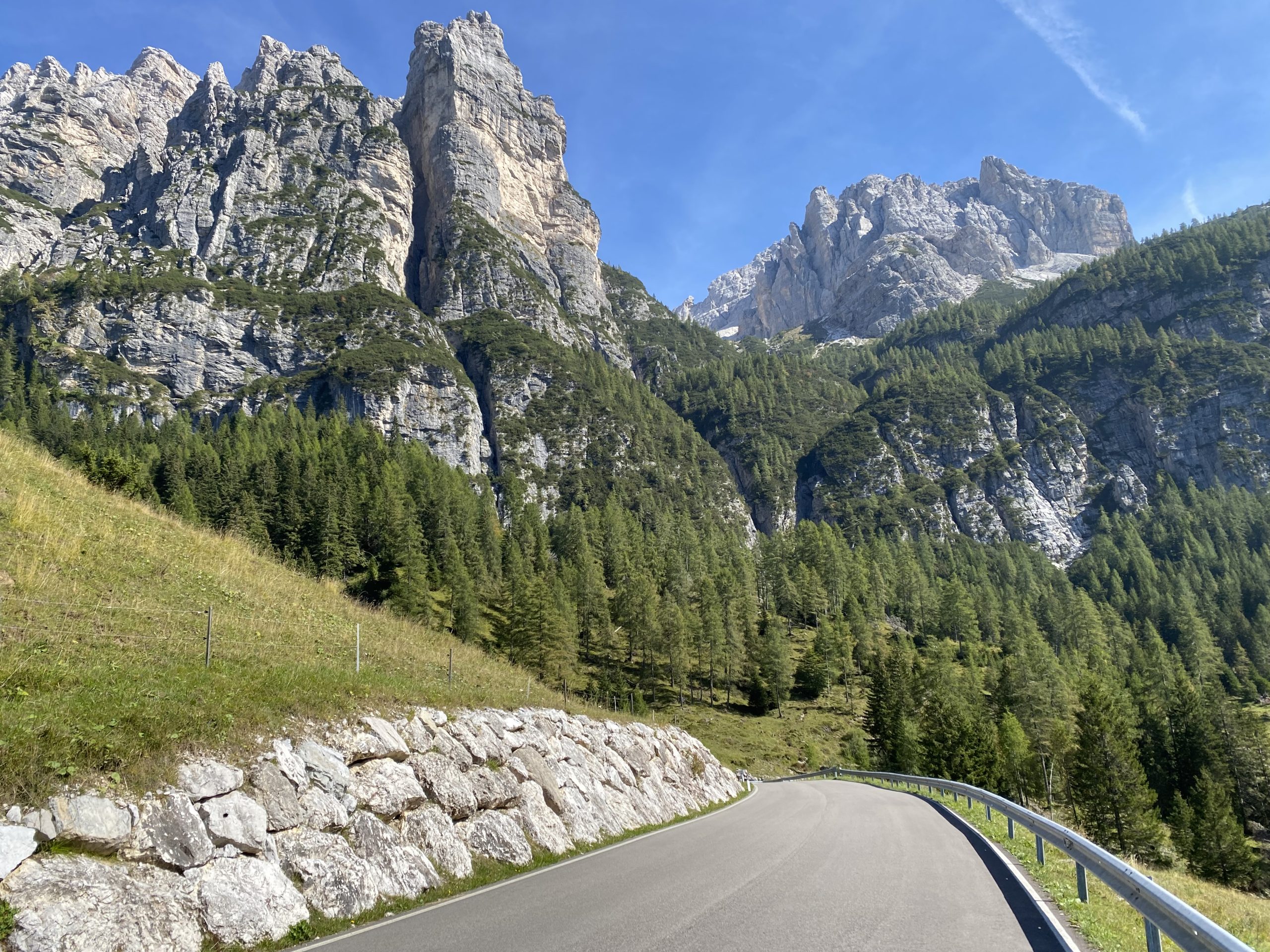
The climb over Passo Giau is perhaps one of the most pastoral and beautiful climbs of the Dolomiti. What a great way to start the day!!
At Selva di Cadore choose from routes with 1, 2 or 3 more climbs and resultant longer distances:
Option 1 climb – down valley to Agordo 112km, 1600m
Option 2 climbs – climb Passo Staulanza and Passo Duran 127km, 2800m
Option 3 climbs – climb Passo San Pelegrino, Passo Valles and Passo Rolle 151km, 4500m
Option 4 descend – cycle the pista ciclabili mostly down stream all the way to Feltre 75 miles with 3400 feet climbing


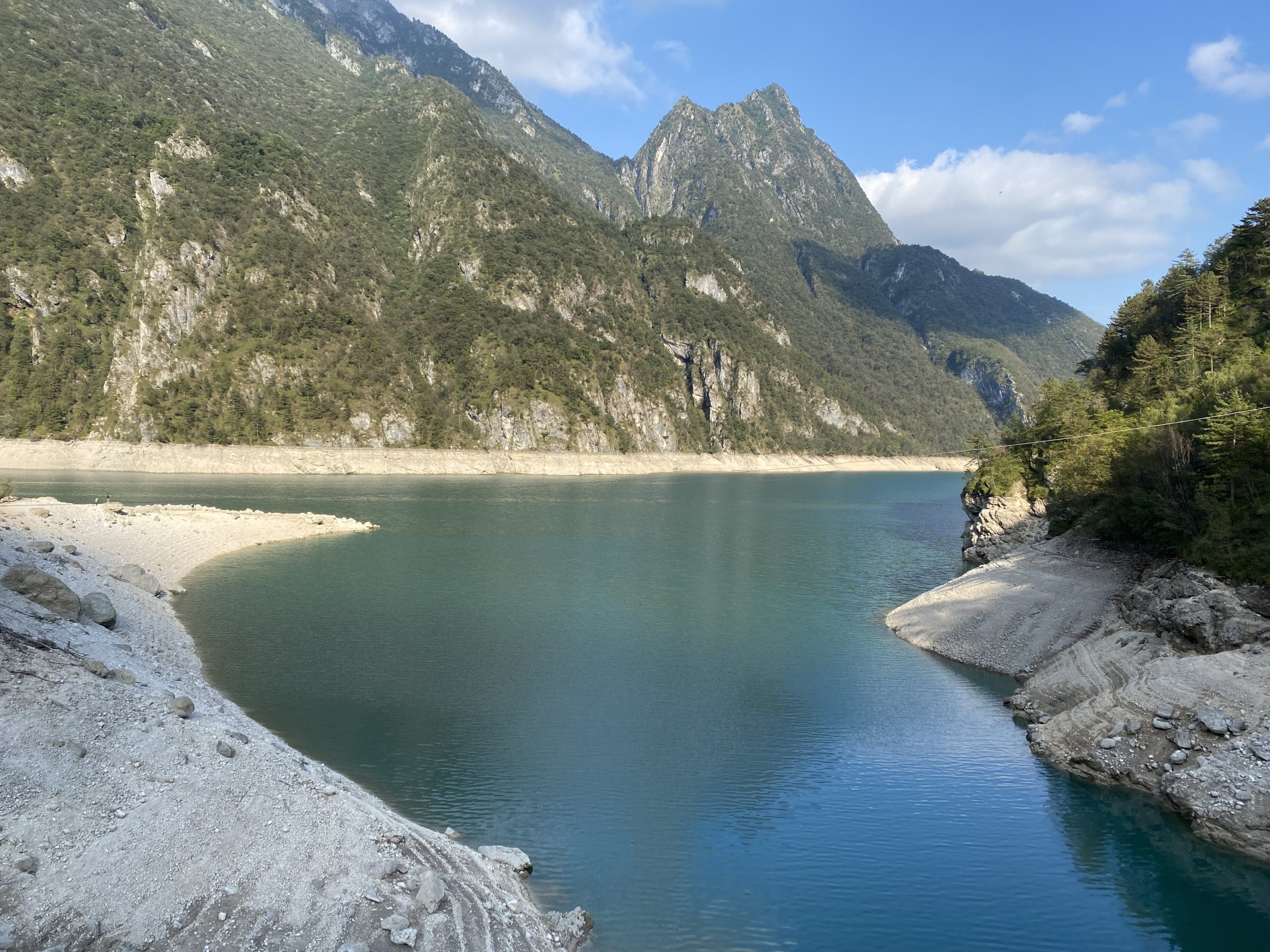

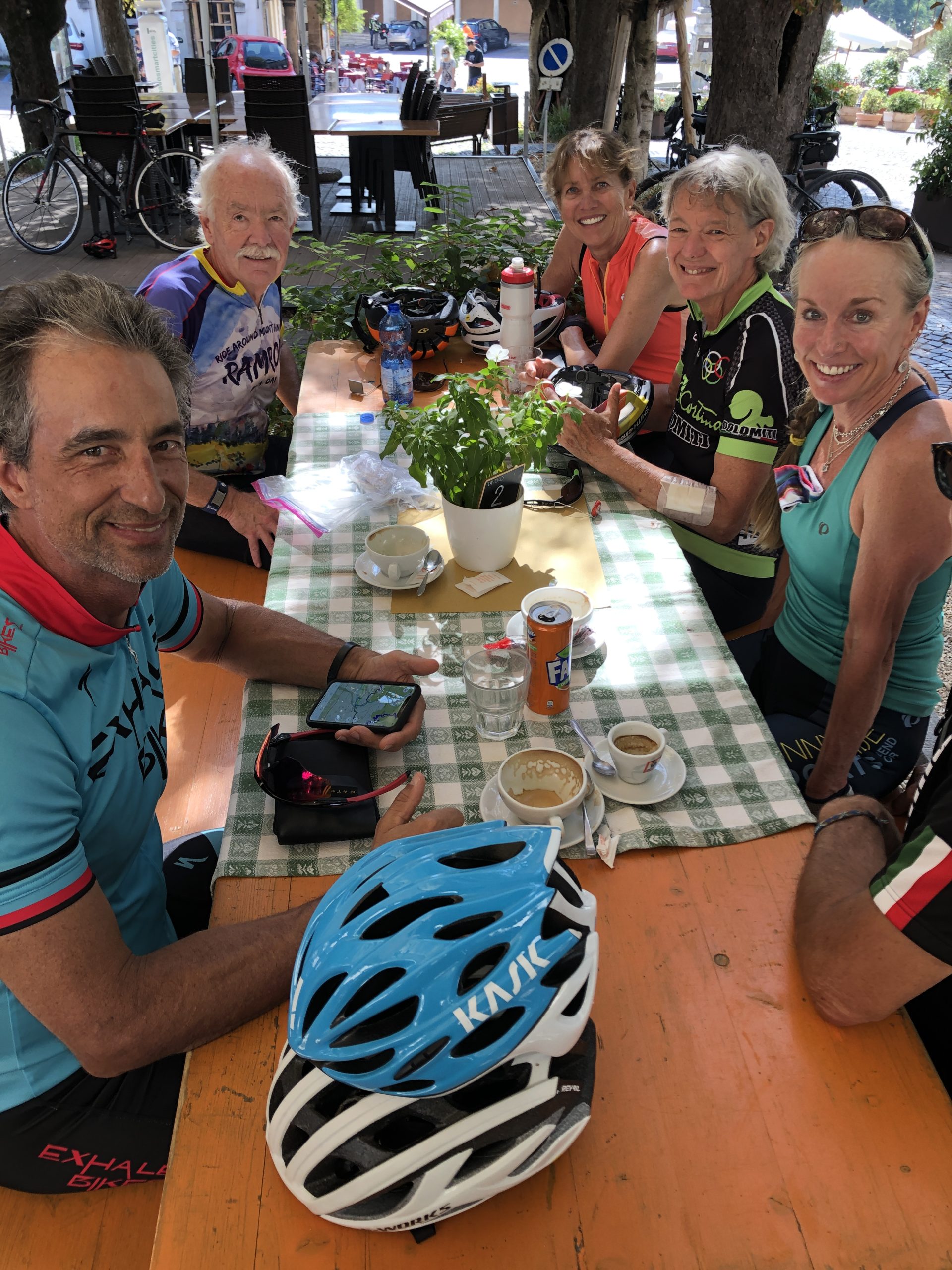
Day 16
Feltre to Castelfranco-Veneto
5 routes
36—75 miles with 900—8800 feet climbing
Our last riding day presents two diversely opposite route choices. Each will be remembered for distinctly differing aspects of topography and energy expenditures. Years ago when I first led a group thru the Dolomiti we stopped at the San Vito bike shop in Cessiomaggiore. It was a tale of two generations with the father and son. We explained that we wanted to ride over Monte Grappa on our return to Castelfranco. We asked which of the two routes from the northside was the quieter road; it was a Sunday and we wanted to stay away from all of the Italian motos that are enjoying the Alpine roads on a Sunday. The son pointed to one road and said “this road is the quietest”. The father pointed to the other road and said “this road is the better road”. So we pedaled thru Feltre after discussing the options intent on riding the quietest road. That day we all learned an important lesson of communicating in a different language and culture. Both men had answered our question perfectly from their individual perspectives. The son correctly pointed us to the quietest road; we did not see a single car on the climb once we crossed a little bridge at the base of the climb. The reason became quite apparent after about 3km, when the grade became so steep it was impossible to remain seated and still keep the pedals moving; one rider literally fell over backwards when he tried to sit to rest his back now aching from the strain. Eventually we made it to the junction with the “other” road, where we discovered a wonderfully paved road with not much traffic AND grades that we could easily sit and pedal comfortably. What the father meant by “this is the better road”, was that you can pedal comfortably. You see, the son answered from the perspective of a 25 year old and the father answered from the wisdom of a 55 year old former racer. The father had assessed our ages and probably abilities before giving his answer, while the son picked his favorite road to send the unsuspecting cyclists on the quietest road that HE enjoys. The take away, consider the life experiences of those from whom you ask information; are they similar to our todays or our yesterdays.
Our choice today, do we want to see what is on top of Monte Grappe enough to ride a 27km climb with an average gradient of 6% with numerous 10-12% short sections. The ride begins with a wonderful rolling warmup on the way to Seren del Grappa where the climbing begins. The summit is a WW-I battle memorial with an always busy restaurant and stunning views into the mighty peaks of the Dolomiti on one side and the expansive Veneto farm and industrial lands. Please be extremely attentive on the descent to Semonzo, as this is a very narrow and twisty road. Once in Semonzo the descending is finished leaving a pleasant 24km spin back to Hotel alla Torre.
The more relaxing choice follows the Pieve river downstream toward Venezia. The road is often busy, but the exceptionally wide shoulders of the roadway make for spirited pedaling and chatting. A turn off of the main road before entering the light manufacturing zone takes us once again over gentle rolling terrain amidst vineyards and farms on the way to rejoining our Asolo loop ride route of two weeks ago. Enjoy!!
DAY 17 – SEPTEMBER, 21, 2025 DEPARTURES, FROM VENICE, ITALY, MARCO POLO AIRPORT (VCE).
Van transfers to Venice, Italy, Marco Polo airport (VCE).
ARRIVAL PLANNING
September 5, 2025 – latest date to arrive into Venice, Italy. Marco Plo Airport (VCE)
Extra Nights can be arranged for guests who arrive prior to 5 September or depart post 21 September,
Airport Transfers will be on your own if you arrive early or depart after the trip ends.
DEPARTURE PLANNING
September 21, 2025 – We will transfer you to Venice, Italy. Marco Plo Airport (VCE) and bid you a found farewell until next time!
